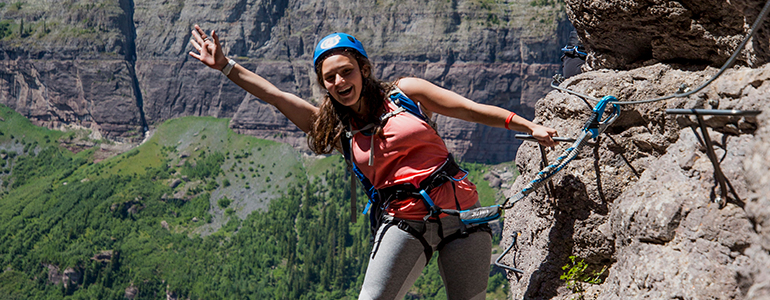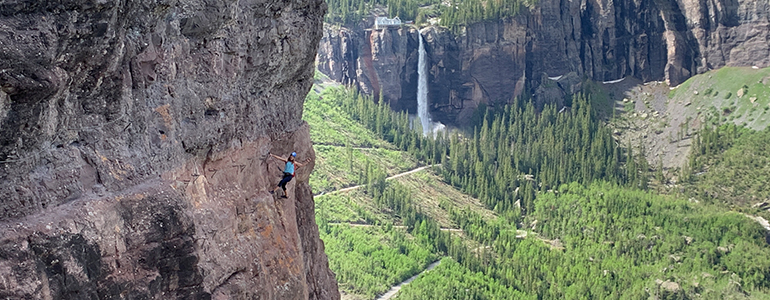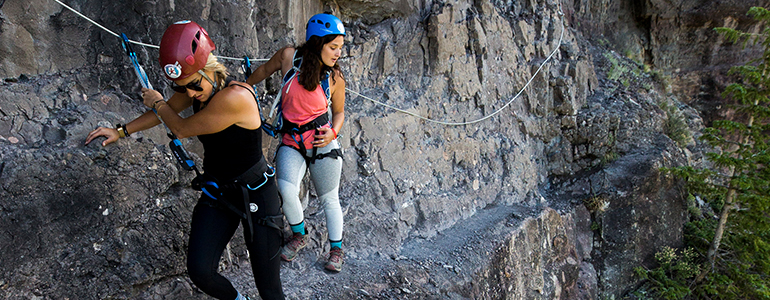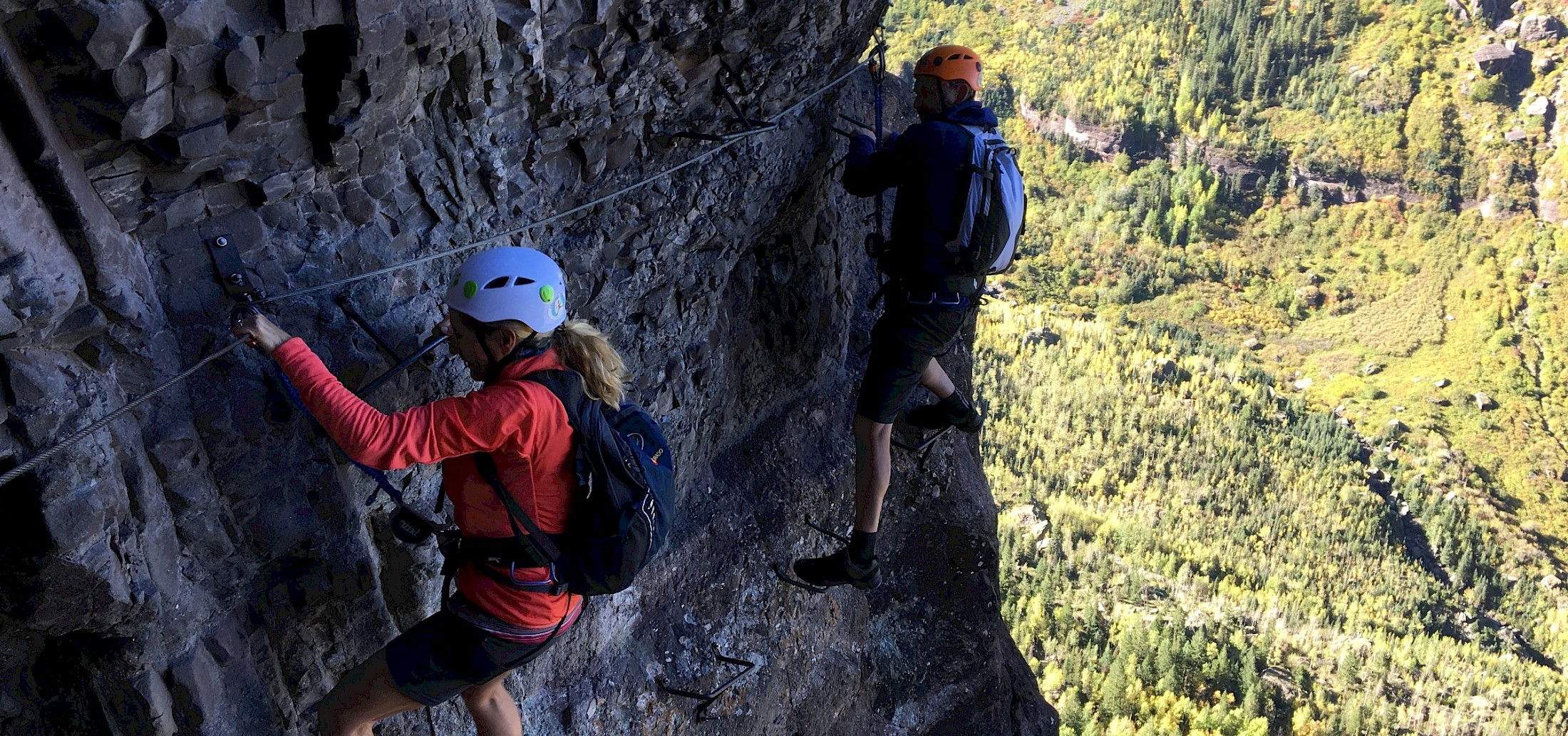Why Telluride's Via Ferrata Should Be On Your Bucket List
You've seen the photos and thought, "who would be crazy enough to do that?" Well, we think you should be those crazy people taking on the Via Ferrata.
Telluride's Via Ferrata is more than just a sightseeing tourist attraction - it was built with love (illegally) by Chuck Kroger, a longtime Telluride local. While Chuck never lived long enough to see this epic "iron rung path" be completed, his legacy - and his daring adventure - live on for everyone to enjoy.

The Via Ferrata is 600 feet off of the ground overlooking the town of Telluride, Ajax and the surrounding peaks. There are several sections of rungs along the route, the most photographed and well-known being the "Main Event", an iconic section of rock wall that leaves climbers suspended on rungs for 200 feet across a vertical cliff.
Sound scary? We think you should add this epic adventure to your bucket list.
Telluride.com: The Via Ferrata was mostly completed by Chuck Kroger - when was it finished?
Mountain Trip: Chuck Kroger was an enigma: a gifted climber, builder and ironworker, who frequently went off gallivanting on alpine adventures around the world, always to return home to Telluride. Kroger passed away in 2007 on Christmas Day, and at that time, the only hardware that was in place at that time were the rungs on the Main Event and a few here and there along the ledge, with no cables whatsoever.
The Main Event was actually the first part of the route to be developed and bolted, with Kroger and his friends. A climber would lead out, generally Kroger, traverse climbing across the vertical face, drilling bolts for protection or hanging from metal hooks (designed for aid climbing). Once they had the bolts in place, they then would lead climb out and clip into bolt protection to begin drilling for the rungs—all of this was done secretly and under the radar.
The cable wasn’t installed until after Kroger died. One of his last wishes was for the route to be safe enough for his wife to traverse, and she wanted to share it with others at his memorial. The cable was installed for the memorial so that others could cross his route in his honor.
Telluride.com: How long did it take to make? Why was it even made in the first place?
Mountain Trip: Technically, it is always still a work in progress. The Telluride Mountain Club spearheaded weekly trail work all last summer to tighten all of the bolts and add more cabled protection along the route.
The original route, without cables, was completed in just a few months before Kroger’s death. He had spent a fair amount of time rambling around the French and Italian Alps, high alpine climbing in terrain where the original Via Ferratas were established, and thought that the San Juans were rugged and beautiful enough to have similar routes.
Telluride.com: Do you have any idea how many people traverse the Via every year?
Mountain Trip: As far as who signs to the logbook at Kroger’s bench, last year about 3,200 signed the registry--but it has been estimated that only about a third of climbers that traverse the route sign the logbook; that number is certainly increasing each year as well.
It’s come a long way from being an obscure—and frankly, illegal—route back in the early 2000s, and is such a cool opportunity for non-climbers and climbers alike to experience vertical terrain.

Telluride.com: We've seen the Via splashed across all sorts of news websites lately... have you seen it grown in popularity over the years?
Mountain Trip: In a crazy way—in fact, we’re seeing people traveling to Telluride just to do the Via Ferrata, and coming back year after year to bring their friends.
The route has such a profound effect on people. The extreme exposure combined with the huge views of the valley far below make an unforgettable experience—one that people tend to share with others they know. It has gotten quite a bit of media attention as well, because it’s such a unique way to enjoy some of the most beautiful terrain in our state.
Telluride.com: What makes it so different than just a regular hike or climb?
Mountain Trip: The fact that it’s not quite either! Rock climbing routes are engineering to be intentionally challenging to a certain grade, you must grasp particular holds in a specific way to move upward successfully, whereas historically via ferratas are intended to make movement through challenging alpine terrain easier. On the Via Ferrata, you can get that feeling of being high on a big wall, without the big wall climbing skills. Additionally, the Telluride Via Ferrata is more of a traverse than a vertical route. The sections of vertical climbing (and down-climbing) are quite short, and the route primarily runs horizontally from east to west along the base of Ajax.
Telluride.com: There are also so many more via ferratas popping up across the country (even in Colorado). What makes this one so different and unique?
Mountain Trip: The nature and spirit of its creation alone makes the Telluride Via Ferrata unique. It was not installed for profit or for any particular reason other than to make a stunning high alpine area accessible for the enjoyment of those without intensive technical climbing skills.
There are very few, if any other, Via Ferratas in the country that are open to the public, on public land, that are maintained to such a high standard.
Telluride.com: The guides at Mountain Trip have done the trip a million times... do you guys still get a thrill out of it?
Mountain Trip: Maybe not quite a million, but our most prolific lead guides are definitely high up in the hundreds! Your psychological reaction to the route definitely changes over time and you end up getting really comfortable. It makes it much easier to help others if you’re not getting serious butterflies or vertigo while hanging out on the rungs. Our guides also spend a lot of time on vertical rock and are generally at ease in a precarious and exposed atmosphere.

Telluride.com: What are some tips for a successful trip?
Mountain Trip:
- Put on sunscreen well before you have to hang on to the rungs.
- Always bring a rain jacket, and make sure to check the forecast—you never know what the weather might do in Colorado in the summertime.
- Try to travel from east to west, the generally recommended direction of travel, so that you wont have to bypass other parties.
- Use the proper gear, including a helmet and Via Ferrata-specific lanyards, and know the route and its severity--if you are not confident in these areas, we would strongly advise people to go with a guide.
- Remember to take in the views; you’re in an exceptionally beautiful place.
- Take it slow, remember to breathe, don’t forget to smile, and have a great time!
PLEASE NOTE: All historical information for this feature was provided by Telluride Mountain Club and the Via Ferrata Sustainability Fund. If you’ve enjoyed the route, please feel free to leave a donation that will go towards continued maintenance of the route and keeping it open to the public.
